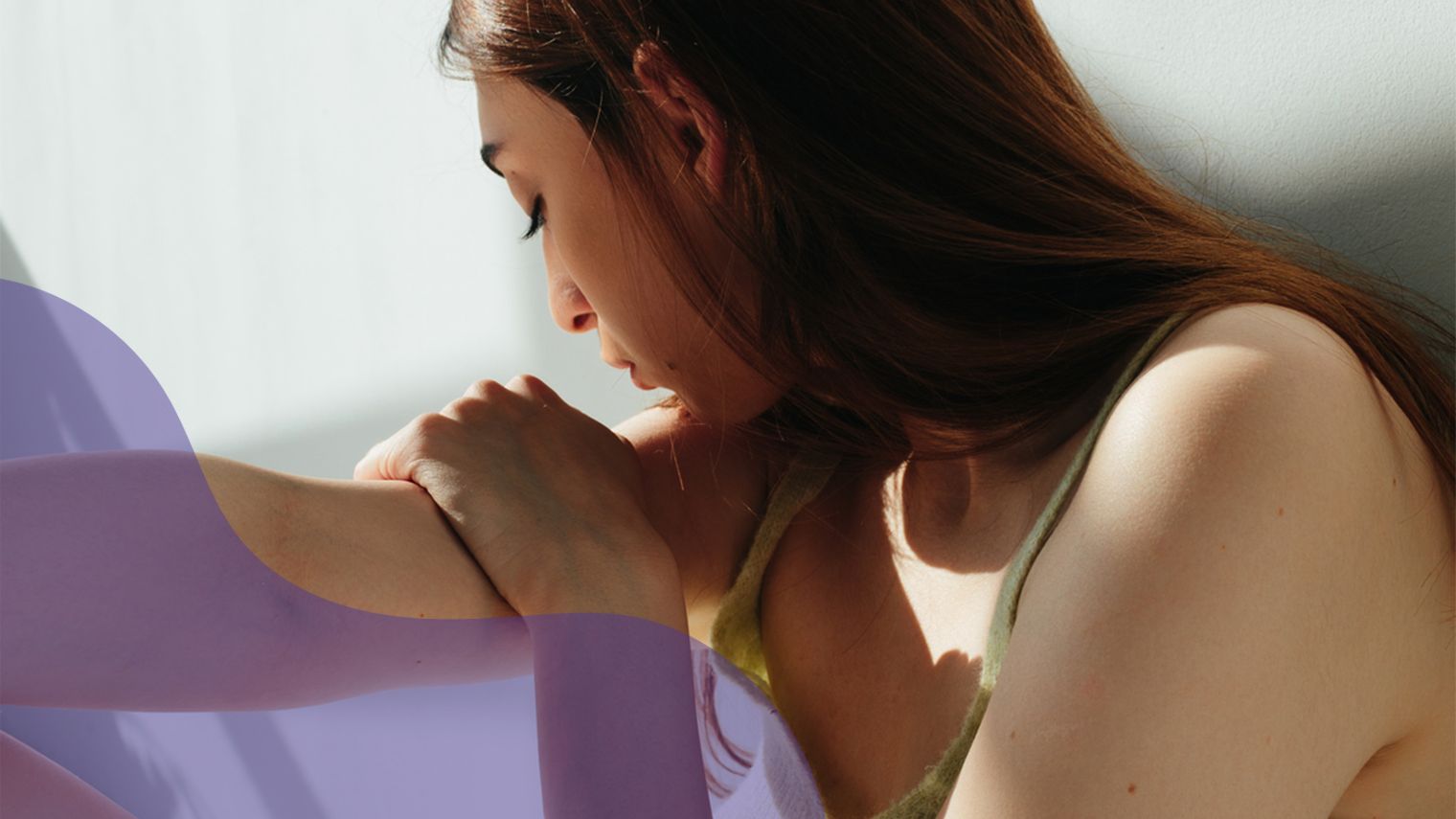When IBD Causes Symptoms Outside Your Gut
January 05, 2023
Content created for the Bezzy community and sponsored by our partners. Learn More

Photography by Sergey Filimonov/Stocksy United
It’s not unusual to experience inflammation and other symptoms in your skin, joints, eyes, or liver. Here’s what to look for.
When you think about inflammatory bowel disease (IBD), symptoms in the gastrointestinal (GI) tract are probably what come to mind first.
But IBD, including Crohn’s disease and ulcerative colitis, can also affect other organs in the body. These effects are known as extraintestinal manifestations (EIMs) of IBD. They can seriously affect the quality of life of people with IBD.
According to a 2011 paper, about 25% to 40% of people with IBD will develop EIMs, though doctors don’t entirely understand why some people with IBD get EIMs and others don’t.
EIMs are sometimes related to inflammation in the GI tract and improve when the inflammation is treated, but other times they occur independently of bowel inflammation.
This means your IBD could be in complete remission but you still experience other symptoms as a result of IBD. Sometimes EIMs of IBD can show up before you receive an IBD diagnosis, and even before the onset of typical IBD symptoms. Other times they show up years after an IBD diagnosis.
The most common EIMs affect the joints, skin, eyes, and liver, but EIMs can show up anywhere in the body.


Arthritis
One of the most common EIMs of IBD is arthritis, especially among people with Crohn’s disease.
One type of arthritis, known as axial arthritis, can affect up to 50% of people with Crohn’s, reports a 2021 research review.
Axial arthritis is inflammatory back pain that most commonly affects the spine and sacroiliac joints (in the pelvis). This type of inflammation can occur with active bowel inflammation but often occurs independently of active IBD.
According to a 2015 research article, peripheral arthritis affects 10% to 20% of people with Crohn’s disease and 5% to 10% of people with ulcerative colitis. It includes inflammation that primarily affects large joints, such as the:
- knees
- hips
- ankles
- wrists
- elbows
- shoulders
This type of inflammation often happens with active bowel inflammation and improves by treating the bowel inflammation. Treatment may include:
- certain biologics
- methotrexate
- short-term steroids
- anti-inflammatory medications
Sacroiliitis, or inflammation of the sacroiliac joints, occurs in up to 50% of people with Crohn’s disease, often without symptoms, notes the 2021 review. When symptoms do occur, they typically involve lower back and buttocks pain that is worse with rest and improves with activity.
Treatment may include:
- certain biologics
- anti-inflammatory medications
- exercise
- physical therapy
Skin
According to the 2021 review, EIMs affect the skin of up to 15% of people with IBD. One skin issue that can occur, known as erythema nodosum, results in very tender red nodules on the shins.
This condition usually coincides with active bowel inflammation and improves with IBD treatment, typically with biologics. Steroids are generally used to calm the intestinal inflammation and nodules more quickly.
Another rarer skin condition, known as pyoderma gangrenosum, affects 0.4% to 2.6% of people with IBD, notes the 2021 review. It generally starts with what seems to be small pimples on the legs, head, neck, or trunk. However, these rapidly develop into a large, deep ulcer.
This condition can occur in people with active or inactive IBD. It’s more common, however, among those with more severe IBD and colonic inflammation. Treatment includes steroids, strong immunosuppressants, or biologics.
Mouth sores, also known as aphthous ulcers, are another common EIM. Prevalence estimates vary widely, but one 2019 review suggests they are much more common in people with Crohn’s disease, affecting anywhere between 0.7% and 20% of adults with Crohn’s.
These sores usually develop inside the lips and cheeks and generally occur when IBD is active. This is not surprising, as the mouth is considered part of the GI tract. If there are sores (ulcers) in the small intestine or colon, there may also be sores in the mouth.
Anesthetic mouthwashes and topical steroids, in addition to treating the IBD, can typically treat these sores.
Eyes
Inflammation of different parts of the eyes can occur in 2% to 7% of people with IBD, more commonly in those with Crohn’s disease, and may occur alongside arthritis, according to the 2021 research review.
Eye inflammation can be painless or painful. If you notice redness in your eyes, eye pain, or changes in your vision, it is important to visit an eye doctor for prompt diagnosis and treatment.
Depending on the type of eye inflammation, treatment may include steroid eye drops or whole body treatments, like biologics, to help calm both the bowel and ocular inflammation.
Liver
Primary sclerosing cholangitis (PSC) is a liver condition marked by inflammation of the bile ducts. It can lead to cirrhosis, liver failure, and cancer of the bile ducts.
The majority of people with PSC have IBD, but most people with IBD will not develop PSC.
PSC develops in up to 5% of people with ulcerative colitis, reports the 2021 review, but it can also develop in those with Crohn’s disease. Without a liver transplant, people with PSC tend to survive 10 to 12 years.
It is not yet well understood what causes PSC, but some treatments are available, like ursodeoxycholic acid. Treating the inflammation of IBD does not improve PSC.
Hepatitis, or inflammation of the liver, can also happen in people with IBD. Autoimmune hepatitis, IgG4-related cholangitis, and granulomatous hepatitis are three types of liver disease that people with IBD can develop.
Some medications doctors prescribe for IBD can lead to hepatitis as well as certain viruses that can reactivate with immunosuppression.
Sometimes stopping the medication that may have caused the hepatitis can treat the condition. Other times immunosuppressants or steroids are required for treatment.
Fatigue
According to the 2021 review, fatigue affects about 50% of people with IBD in remission and more than 80% of people during a flare.
Active IBD inflammation is known to cause fatigue, but it is not well understood why people with IBD in remission experience fatigue often as well. This fatigue may be related to circulating inflammatory proteins and alterations in the microbiome.
Fatigue can be very difficult to treat, but in general, it is always important to treat the underlying inflammation.
The takeaway
While gut issues are the most well-known symptoms of IBD, extraintestinal manifestations (EIMs) of IBD are also very common and can be quite serious.
Some EIMs happen due to active inflammation, so it’s important to do your best to work with a healthcare professional to manage your IBD.
If you notice any concerning symptoms or changes in your body, especially during a flare, let a healthcare professional know right away. Together, you can begin prompt treatment.
Medically reviewed on January 05, 2023
4 Sources


Like the story? React, bookmark, or share below:
Have thoughts or suggestions about this article? Email us at article-feedback@bezzy.com.
About the author